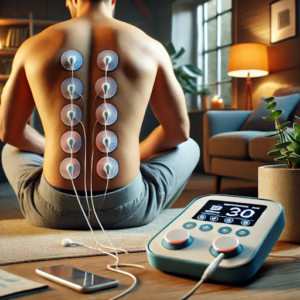Effectively Managing Back Pain Through Electrotherapy
Back pain is a widespread issue affecting millions worldwide, transcending age, gender, and lifestyle factors. It can manifest in various ways, from sharp discomfort lasting a few days to chronic pain that persists for months or years. Often, back pain stems from a combination of physical, psychological, and environmental factors.
Common causes of back pain include muscle strain, herniated discs, arthritis, and poor posture. The variability in how back pain is experienced complicates diagnosis and treatment. While some may find the pain tolerable, others could be severely debilitated, requiring a comprehensive approach from healthcare professionals.
Beyond physical health, chronic back pain can take a toll on emotional well-being, often leading to anxiety, depression, and social isolation. The economic implications are substantial, as back pain is one of the leading causes of disability and reduced productivity in workplaces.
Understanding the underlying causes of back pain is crucial for developing effective treatment strategies. One such strategy is electrotherapy, which has gained recognition for its ability to relieve pain and promote recovery.
Summary
- Back pain may result from factors like poor posture, muscle strain, or injury and significantly impact daily life.
- Electrotherapy is a non-invasive technique that uses electrical energy to manage pain and promote healing.
- Electrotherapy offers pain relief, muscle relaxation, improved circulation, and reduced inflammation.
- Different electrotherapy methods like TENS and EMS can help alleviate back pain.
- When using electrotherapy, it’s important to follow healthcare professional advice and avoid using it near the heart or on broken skin.
 Introduction to Electrotherapy
Introduction to Electrotherapy
Electrotherapy refers to various techniques that use electrical energy to treat conditions like back pain. This therapeutic approach has evolved, utilizing advanced technologies to offer pain relief and promote healing. Electrotherapy can target specific areas of discomfort by stimulating nerves and muscles through electrical impulses.
Unlike medications, which may cause side effects or dependency, electrotherapy is non-invasive and effective in managing back pain. As research continues, the benefits of electrotherapy are becoming more widely recognized, leading to its integration into comprehensive pain management plans.
Benefits of Electrotherapy for Back Pain
One of the primary benefits of electrotherapy is its ability to provide immediate pain relief. Elect electrotherapy interrupts pain signals by sending electrical impulses to the affected area, reducing discomfort.
Additionally, it promotes the release of endorphins, the body’s natural pain relievers, further enhancing its effectiveness. Electrotherapy also improves blood circulation and reduces inflammation, supporting the healing process. This combination of immediate and long-term benefits makes electrotherapy a valuable tool for managing back pain.
Types of Electrotherapy for Back Pain
Electrotherapy encompasses various methods, each targeting different aspects of back pain management. TENS (Transcutaneous Electrical Nerve Stimulation) is a popular technique that delivers low-voltage electrical currents to relieve pain. Its portability and ease of use make it ideal for home treatment.
IFC (Interferential Current Therapy) uses medium-frequency electrical currents to reach deeper tissues and address musculoskeletal issues. Additionally, EMS (Electrical Muscle Stimulation) and microcurrent therapy are increasingly recognized for stimulating muscle contractions and aiding tissue repair.
 How to Use Electrotherapy for Back Pain Management
How to Use Electrotherapy for Back Pain Management
Following specific guidelines is crucial to ensuring safety and effectiveness when using electrotherapy. Patients should consult a healthcare provider to determine the best electrotherapy option. Once a treatment plan is in place, therapy can be administered in a clinical setting or with portable devices at home.
Home users must follow the manufacturer’s instructions for electrode placement, intensity, and session duration. A typical session lasts between 20 and 60 minutes. Consistency is key, as regular treatments offer cumulative benefits over time. Regular communication with a healthcare provider is essential to track progress and make adjustments if needed.
Precautions and Considerations When Using Electrotherapy
Although electrotherapy is generally safe, certain precautions should be taken to avoid complications. Individuals with heart disease, epilepsy, or implanted devices like pacemakers should consult a healthcare provider before using electrotherapy. Pregnant women are also advised to avoid electrotherapy near the abdomen or lower back.
It is important to avoid placing electrodes on open wounds or infected areas. Patients should also monitor their bodies for adverse reactions during treatment and stop immediately if they experience increased pain or skin irritation.
 Integrating Electrotherapy with Other Back Pain Management Techniques
Integrating Electrotherapy with Other Back Pain Management Techniques
Integrating electrotherapy with other treatments can enhance back pain management. A holistic approach often yields better results than relying on a single therapy. Combining electrotherapy with physical therapy can strengthen muscles and improve flexibility while addressing underlying musculoskeletal problems.
Making ergonomic adjustments at work or home can further enhance the benefits of electrotherapy by reducing strain on the back. Additionally, incorporating stress-reducing practices like yoga or meditation can help alleviate pain perception by promoting relaxation.
FAQs
Can you tell me about electrotherapy for back pain?
Electrotherapy uses electrical stimulation to manage and relieve back pain—standard methods in inStandardTENS and EMS.
How might electrotherapy help with my back pain?
Electrotherapy stimulates nerves and muscles to improve blood flow, promote healing, block pain signals, and trigger the production of endorphins, the body’s natural painkillers.
Is it safe to use electrotherapy for back pain?
Electrotherapy is generally safe when guided by a trained healthcare provider. Follow recommended protocols and avoid applying the device near the head or heart.
How does electrotherapy work for back pain?
Electrotherapy relieves pain, reduces muscle spasms, and improves flexibility. It’s a non-invasive and drug-free option for managing back pain.
Who can benefit from electrotherapy for back pain?
Electrotherapy may benefit individuals with conditions such as strained muscles, arthritis, sciatica, or herniated discs as part of a broader pain management strategy.
Are there any situations where electrotherapy isn’t recommended?
Electrotherapy is not recommended for individuals with pacemakers, epilepsy, or heart conditions. Consult a doctor before starting treatment.
Brought To You By: Back Pain Therapy
The Article: Managing Back Pain with Electrotherapy appeared first on https://mcrtherapies.co.uk
The Article Managing Back Pain with Electrotherapy appeared first on https://mcrtherapies.com
The Article Managing Back Pain with Electrotherapy Was Found On https://limitsofstrategy.com



The complexities of managing back pain really resonate with me, as I’ve struggled with it for several years now. It’s true that the causes can vary widely, often making it a challenge for both patients and healthcare providers to pinpoint the exact issues at play. I’ve experienced everything from muscle strains to chronic discomfort, and I’ve found that the emotional toll can be just as significant as the physical pain.
I can really empathize with your experience. Back pain is such a tricky issue, especially considering how it can stem from so many different sources. It’s interesting how we often focus on the physical aspects of pain, but the emotional side can be just as consuming. I’ve noticed in myself that when my back flares up, it can lead to a bit of a downward spiral emotionally, impacting everything from my motivation to my relationships.
It’s true; back pain can turn into a complex web of challenges that goes beyond just the physical. I’ve found that when I’m grappling with discomfort, it often brings up feelings of frustration or helplessness, which can spill over into everyday life. It’s like a ripple effect that touches every aspect, from motivation to social interactions.
I can relate to that feeling you describe—the way emotional and physical challenges intertwine can be overwhelming. It’s interesting how back pain can manifest not just in our bodies but also in our minds and social lives. I’ve noticed that when I’m in discomfort, I tend to withdraw from social gatherings or even find it hard to engage with friends. It’s as if the pain erects this invisible barrier that makes it tough to connect.
I totally get what you mean. Back pain really knows how to mess with every part of life, doesn’t it? It’s wild how something physical can ripple out into our emotional state. I’ve found that when my back is acting up, it’s like a domino effect—first, there’s the pain, then comes the frustration, and before you know it, I’m spiraling into a funk where even the simplest tasks feel monumental.
It’s refreshing to hear you share such a personal perspective on back pain and its ripple effects. There’s definitely a dual nature to it—physical discomfort and the emotional struggle that often tags along. I’ve found myself in similar shoes, where a flare-up doesn’t just halt physical activity, but creates this mental fog that seems to wrap around everything. It can change how we view not only ourselves but also our interactions with others.
I completely relate to what you’re saying about the emotional toll of back pain. It’s fascinating how intertwined the physical and emotional aspects are. I’ve had my own struggles with back issues, and I can definitely confirm that when the pain flares up, it doesn’t just affect my body. It seeps into my mood and motivation, often making it hard to focus on anything else.
It sounds like you’ve been on quite a journey with your back pain. The emotional toll you mentioned really strikes a chord. It’s easy to overlook how debilitating chronic pain can affect not just our physical abilities but our mental health and overall well-being. I’ve had my fair share of struggles with various aches and pains, and I can relate to how those constant discomforts can wear you down mentally over time.
It sounds like you’ve been through a lot with back pain; I’ve come across some interesting insights on how infrared light therapy might offer a new approach to managing that discomfort.
‘Infrared Light Therapy: Harnessing Its Healing Power for Pain Relief’
https://writebuff.com/infrared-light-therapy-harnessing-its-healing-power-for-pain-relief/.
You’re completely right about the emotional toll that chronic pain can take. It’s not just about physical discomfort; it layers on anxiety, frustration, and often a sense of isolation. Each day can feel like a challenge, especially when you’re managing pain that seems to have no end in sight.
You’re so right about the emotional layers of chronic pain. It can be such a complex struggle, feeling trapped in a body that doesn’t always cooperate. I think a lot about how isolating it can be, even in a room full of people. There’s often this invisible barrier where others may not really understand what you’re going through.
I can relate to the emotional weight of chronic pain, and I recently came across some insights on how electrotherapy might offer a glimmer of hope for muscle revitalization and overall relief.
‘Muscle Revitalisation with Electrotherapy’
https://writebuff.com/muscle-revitalisation-with-electrotherapy/.
It’s wild how back pain can feel like that one friend who never knows when to leave the party, right? It sneaks in, makes itself comfortable, and turns what should be a good time into a game of “Can I stand up without grimacing?”
I relate so much to that idea of back pain being like that persistent friend at a party. It really does have a knack for interrupting the good times and making everything feel awkward. I remember a few years back when my lower back decided to go on strike, and it shifted everything—from how I moved to even how I felt mentally. Instead of enjoying social events, I was playing this mental game of “how can I position myself comfortably while still engaging.”
Managing back pain can feel like navigating a complex maze, especially when you’ve been through it for several years. The journey is often filled with ups and downs, and it sounds like you’ve had your share of both. The variety of causes—from muscle strains to more chronic discomfort—can make it frustrating not just for those of us experiencing it, but also for the healthcare providers trying to help us. Each individual’s experience is unique, and that’s part of what can make treatment so difficult.
Your exploration of back pain management through electrotherapy offers valuable insights into a multifaceted health issue that truly affects many aspects of a person’s life. The holistic approach you’re advocating resonates with my experiences, as well as those of friends and family who have faced similar challenges.
It’s great to hear how the exploration of electrotherapy for back pain resonates with your experiences and those of your friends and family. Back pain is such a complex issue, and it really does touch so many aspects of life—whether it’s affecting daily activities, work productivity, or just the joy of enjoying time with loved ones.
It’s interesting to see the connection between physical and emotional well-being highlighted in your post. I’ve personally experienced how managing back pain can positively shift one’s outlook on life. After trying various treatments, I found electrotherapy to be particularly beneficial. It not only alleviated the persistent pain but also helped reduce my anxiety levels associated with chronic discomfort.
This is such an important topic, and I appreciate how you’ve laid out the complexity of back pain and its far-reaching effects. It’s interesting to see how back pain isn’t just a physical ailment but a multifaceted issue affecting emotional well-being and socioeconomic status, too.
This blog post truly underscores the multifaceted nature of back pain and its impact on our lives. Personally, I’ve experienced how debilitating chronic back pain can be, not just physically but also emotionally. It’s fascinating to see how many layers are involved in understanding this condition—how it intertwines with our mental health and daily functioning.
Your insights really resonate. Chronic back pain is such a complex experience, and it’s true that its reach goes far beyond physical discomfort. I often think about how our emotions and mental health can create a feedback loop with pain. When we’re struggling with pain, it can lead to frustration, anxiety, or sadness, which then can amplify our perception of that pain. This connection isn’t just a psychological concept; it’s something many of us face daily.
Your exploration of back pain and its multifaceted nature resonates deeply with my own experiences and those of many others I know. I’ve witnessed the profound impact back pain can have on an individual’s life—not just physically, but holistically. The interplay of physical, psychological, and environmental factors you mentioned is indeed complex and often overlooked.
It’s refreshing to hear that my exploration of back pain aligns with your experiences. You’re spot on about the depth of this issue—it really can turn daily life upside down. The way physical discomfort meshes with mental strain and our environment’s influence is often brushed aside.
Your exploration of back pain management through electrotherapy is such an important topic. Back pain truly affects so many aspects of life, and it’s refreshing to see more discussions around various management strategies, especially as personalized approaches to treatment become increasingly relevant.
Your thoughts on back pain management resonate deeply. It’s a struggle that many face, and finding the right approach is often a journey in itself. Electrotherapy is one option that has shown promise, but it’s fascinating how individual experiences can vary so widely. Some people find significant relief, while others might not feel much difference at all.
It’s so true how back pain affects every aspect of life. I’ve been dealing with it on and off for years, and I’ve really noticed how it’s not just about the physical discomfort. It alters your mood and even your social life – it’s hard to plan outings when you’re unsure how your back will feel that day.
It’s interesting how layers of back pain ripple out into so many parts of life, right? It’s not just the ache; it seeps into how we relate to others and enjoy our favorite activities. I totally get the struggle of planning outings when the uncertainty of pain looms over the day. It can make you feel stuck or even isolated, especially when you see friends making plans that you just can’t fully commit to. Have you found any strategies that help you manage both the pain and the uncertainty? Sometimes, even simple adjustments or small self-care practices can make a difference.
I really appreciate how you’ve highlighted the complex nature of back pain—it’s so true that it goes beyond just the physical symptoms. I’ve had my own struggles with back issues, and it’s fascinating to see how they can intertwine with mental health. For me, the psychological aspect was profound; the anxiety of not knowing how bad it would get made things feel even worse.
I really appreciate your in-depth exploration of back pain and the multifaceted approaches to managing it through electrotherapy. As someone who has dealt with chronic back pain myself, I can relate to the struggle of finding effective relief amidst the overwhelming number of treatment options available. It’s interesting how back pain doesn’t just affect physical health but also influences emotional and social aspects of life. I remember a time when my pain flared up so intensely that it impacted my ability to work and engage with friends, leading to some feelings of isolation and frustration.
Your exploration of back pain and its multifaceted nature truly resonates. I’ve experienced back pain firsthand, and it has opened my eyes to just how interconnected physical and emotional health can be. Initially, I dismissed my discomfort as a minor issue, but it quickly became evident that stress and anxiety significantly compounded my pain—a reality that many may not recognize until they’re in a similar situation.
Your exploration of back pain and the role of electrotherapy is not only timely but also underscores a multifaceted issue that impacts many lives daily. Personally, I have navigated my own journey with back pain, which has shed light on the complexity of this condition and the various dimensions that come into play—not just the physical pain itself but also the psychological implications and lifestyle adjustments one must make.